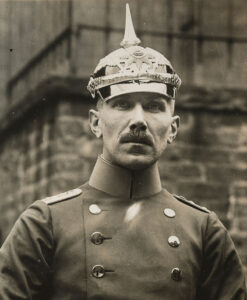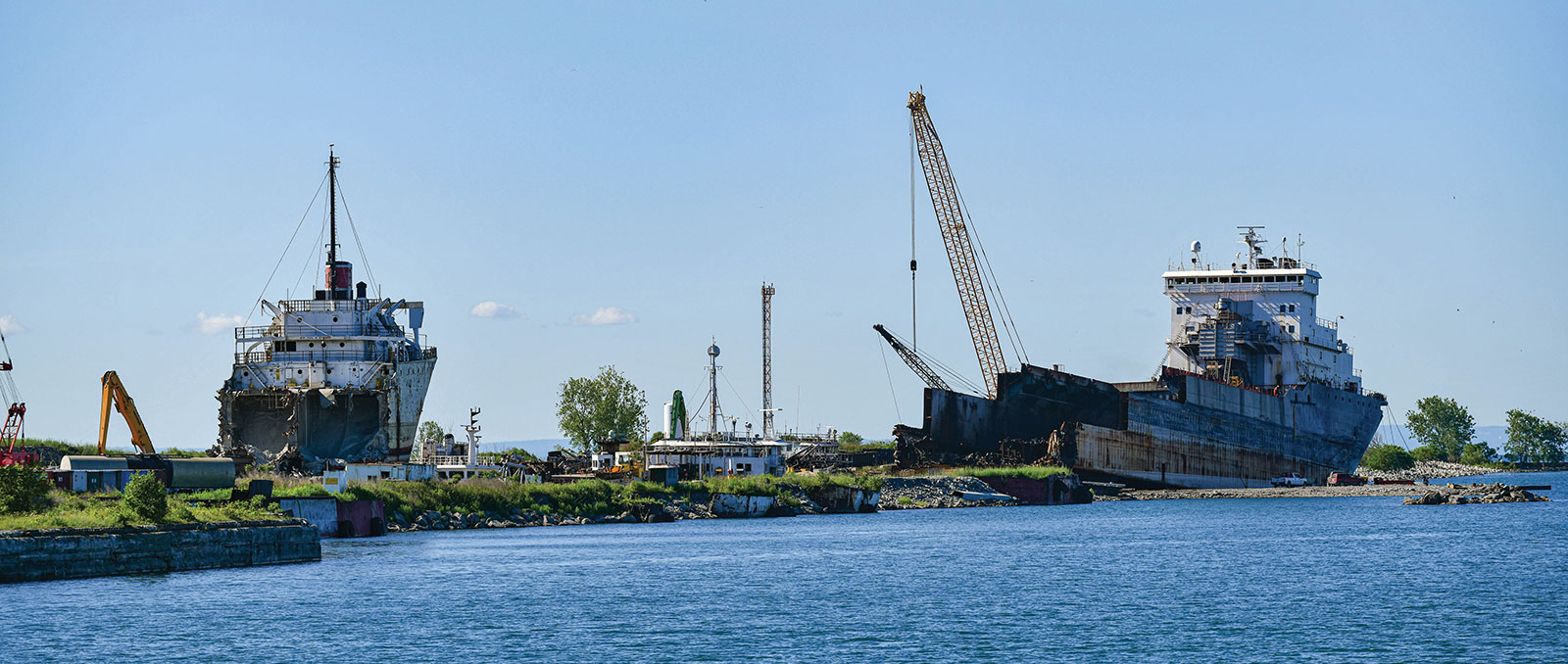Photo Courtesy of City of Port Colborne
While many Great Lakes communities can claim a maritime heritage, none continue to build one quite like Port Colborne, Ontario. Its remarkable history and delightful present-day charms make this wonderful city a bucket list stop for every Great Lakes boater.
Virtually every city, town and village on the Great Lakes owes its very existence to the water itself, having been originally established after someone waded ashore and thought, yes, we’ll build it here.
While some of these settlements have seen their shorelines subsequently industrialized to the point that residents lost their connection to the lakes, not so for the bustling, southern Ontario city of Port Colborne. Situated on the eastern end of Lake Erie where it marks the upstream entrance to the Welland Canal, Port Colborne maintains its deep tie to the lakes in a very profound way — and that’s evident from the moment you arrive.
Finding Port Colborne is about as easy as it gets. Located on the north shore of Lake Erie some 47 miles east of Long Point and 18 miles west of Buffalo, the city of just under 20,000 people straddles the Welland Canal as its southern terminus. Accordingly, the approach into port is wide-open, with the greatest obstacle being the regular parade of lake freighters, salties and tankers making their way to and from the canal. At times traffic can be busy, so keep an eye out for the big boats and always give them a wide berth for safety.
It’s a good idea to stay a mile or so offshore as you approach Port Colborne, in part to allow yourself plenty of wiggle room should one of the big boats emerge from the canal, and in part to skirt the sandy shoals that extend for some distance underwater off Morgan’s Point to the west and Point Abino to the east.
The canal entrance is clearly visible from a considerable distance offshore — you’ll first spot the enormous grey hulk of the Port Colborne Grain Terminal situated on the canal’s west bank, then the twin breakwalls identifying the canal entry channel itself. Note that as you enter Port Colborne’s harbor, you are entering the St. Lawrence Seaway System and traveling downstream, and that is reflected in the marker buoys; as you enter from Lake Erie, keep green to starboard and red to port.
As you clear the breakwaters you’ll want to immediately turn 90 degrees to the west, rather than continuing into the canal proper. Just beyond the grain terminal you’ll spot the wide entrance channel leading into Sugarloaf Marina, Port Colborne’s city-owned leisure boating facility.
With more than 700 slips, including transient docking wthe ideal home base for boaters visiting Port Colborne. The marina, with diesel, gas, pump-out and full repair and maintenance facilities, offers an on-site restaurant and pub, a barbecue and picnic area, and a shuttle service to Port Colborne’s bustling downtown. But most visitors skip the ride and simply walk into town, or enjoy the excuse for an easy bike ride and a chance to stretch their legs along the inviting multi-use path that connects the marina to the city core.
Immediately north of the marina, H. H. Knoll Lakeview Park offers a wonderful playground for kids, facing a conveniently located ice cream stand. There’s also Big Momma’s Fries, which smell appropriately incredible and taste even better. Seats overlooking the water provide the perfect spot to enjoy your treats in comfort while surveying the bay for herons, turtles, terns and even the occasional osprey.
An unparalleled maritime heritage
First settled by United Empire Loyalists in 1832 as the hamlet of Gravelly Bay, Port Colborne is named for Sir John Colborne, a British war hero who served as Upper Canada’s Lieutenant Governor when the first Welland Canal opened in 1833.
With its position at the head of the canal, and fueled by an endless stream of maritime trade, the tiny settlement grew quickly, incorporating as a village by 1870, becoming a town in 1918, and re-incorporating into the present-day city in 1966.
Port Colborne has long been popular with visitors, particularly American tourists. By the late 1800s, a number of wealthy U.S. industrialists built stately summer homes there, forming the nucleus for a gated community just west of the canal that became known as the Humberstone Club. A number of these stately residences remain today, lining Tennessee Avenue as it meanders through one of Port Colborne’s most desirable neighborhoods. The classical southern architecture incorporated in the design of these buildings, with their clap siding, multiple vertical columns and extensive verandahs facing the water, went on to define a local architectural style that can be seen in several other historic buildings scattered throughout the town. The original handmade Humberstone Club wrought iron gates also remain visible today, where Tennessee Avenue meets Sugarloaf Street.
But by far the greatest architectural marvel in town is the canal itself. Today’s Welland Canal is actually the fourth version, each one built successively wider and deeper than the previous to accommodate larger and deeper ships. Construction of today’s canal began in 1913, was put on hold by the first world war, and was ultimately completed in 1932.

Photo by Craig Ritchie
The Welland Canal bomb plot
 As critical infrastructure, it comes as no surprise to learn that the Welland Canal has been subject to its share of sabotage attempts over the years. Yet none quite equal the infamous 1914 bomb plot hatched by a group of German spies in the opening days of the first world war.
As critical infrastructure, it comes as no surprise to learn that the Welland Canal has been subject to its share of sabotage attempts over the years. Yet none quite equal the infamous 1914 bomb plot hatched by a group of German spies in the opening days of the first world war.
Led by German military attaché Franz von Papen (pictured left) and Count Johann von Vernstorff, the German ambassador to the United States, the plot called for a group of six German agents to place explosive charges at multiple points on the canal, including what is today Lock 8 in Port Colborne. Taking advantage of ongoing construction work to enlarge the facility, the plot aimed to destroy the locks and plug the canal completely, thereby disrupting shipments of steel, ore and other critical goods.
Suspicious federal agents in both Canada and the U.S. had been monitoring the Germans from the beginning, and broke up the bomb plot before it could be carried out. Franz von Papen escaped arrest, however, having been previously deported on other charges only days before the full extent of his involvement in the canal plot was understood. A subsequent arrest warrant against him was only dropped in 1932, when he was appointed Chancellor of Germany.
Photo by Craig Ritchie
A ship-watching mecca
While many Great Lakes ports can claim a historic maritime heritage, Port Colborne’s good old days continue right into the present, making it a major draw for ship spotters. Depending on weather, the annual shipping season usually runs from late March until some point before Christmas, with the canal’s eight locks accommodating vessels to 740 feet in length and 80 feet in width. Along the canal’s 27-mile length between Lake Erie and Lake Ontario, elevation drops by an astounding 326 feet. Freighters typically transit the canal in about 11 hours.
Vessels traveling downbound from Lake Erie must first pass the Clarence Street Lift Bridge, or Welland Canal Bridge 21 in official-speak. Built in 1928, the vertical lift bridge is an iconic Port Colborne landmark, raising the road surface 120 feet to allow vessel passage. It’s one of only three vertical lift bridges remaining on the canal, with its western approach spanning the former Locks 26 and 27 of the second-generation canal, completed in 1854. The original cut stone lock structures are still clearly visible today.
Just downstream of the bridge is the present-day Lock 8, the first water level control structure that ships pass through on their way to Lake Ontario. At 1,380 feet in length, Lock 8 is one of the longest canal locks in the world. The structure is a control lock, built to regulate water levels in the system while raising or lowering ships anywhere between 2 and 4 feet, depending on Lake Erie water levels.
The adjacent Lock 8 Gateway Park, located where Main Street West meets the canal, makes a pleasant spot to watch the big ships come and go, with its picnic pavilion, an elevated viewing platform, flower gardens, picnic tables, fountains and restrooms. A number of interpretive signs explain how the lock works and identify the types of ships that visitors can see. Information on ship schedules and destinations can be found at the Visitor Information Centre, located on Mellanby Avenue directly across from the park.
A different kind of ship watching can be found at the base of West Street, where ship spotters enjoy a clear view across the canal of the Marine Recycling Corporation’s ship recycling facility. More than just the place where old lakers go to die, the Port Colborne yard is a testament to the ecological sustainability of the shipping industry, where old vessels at the end of their service life have been neatly recycled into all sorts of other useful products since long before sustainability became fashionable. At any given time, Port Colborne visitors are likely to see two or three retired lakers meeting the cutting torch on the way to their next life, and it is indeed interesting to observe the process in action.
Ship watching in all of its forms is an extremely popular pastime in Port Colborne, celebrated each August during the annual Canal Days Marine Heritage Festival. This truly one-of-a-kind nautical extravaganza typically includes tall ship visits and tours, free concerts, street vendors, buskers and ship spotting, of course. Cancelled in keeping with COVID-19 restrictions in 2020 and 2021, Canal Days is scheduled to return with a bang in 2022, with details expected to be announced in the spring.
 Only steps from the canal, Port Colborne’s Historical and Marine Museum is another major draw for visitors, with a wide range of interpretive exhibits including an on-site heritage village celebrating the town’s unique past. With more than 19,000 artifacts in its extensive collection, the museum attracts more than 16,000 visitors each year.
Only steps from the canal, Port Colborne’s Historical and Marine Museum is another major draw for visitors, with a wide range of interpretive exhibits including an on-site heritage village celebrating the town’s unique past. With more than 19,000 artifacts in its extensive collection, the museum attracts more than 16,000 visitors each year.
While you’re there, pop into Arabella’s Tea Room, for authentic afternoon tea in true Edwardian style. There’s no better way to get a taste for Port Colborne’s fascinating history — literally.

Photo Courtesy of City of Port Colborne
The hub of activity
While Port Colborne’s marine heritage is by far its biggest draw, there’s a lot more in stow for visiting boaters, and that includes anyone in need of a little retail therapy after days on the boat. Port Colborne’s lively downtown stands out with its vast assortment of small, locally owned businesses and dearth of generic chains. Many of these charming boutiques are located on Clarence Street, which parallels the lakeshore, and West Street, which parallels the canal from the Clarence Street Bridge to the lake.
With its curious shops facing the canal and the Port Promenade pedestrian walkway, West Street, in particular, is a perennial favorite among locals and visitors alike. Here you’ll find a diverse range of boutique shops from clothing stores to nautical gift stores to lavender emporiums to specialty bee boutiques with honey, beeswax, candles, teas and more.
If you’re looking for a bit of indulgence, you’ll also find a number of wellness shops and spas. Or if you’re in need of a snack between shops, you’ll find an assortment of tea rooms, coffee bars and the ever-popular Pie Guys Bakery & Café, catering to every taste. At some point in your stay, you’ll definitely want to call in on Minor Fisheries, for what is widely claimed to be the best fish and chips on the Canadian side of the lake. Or try the Canalside Pub and Eatery, which is particularly popular among Port Colborne locals.
Just a few steps north of the Clarence Street Bridge, Walter’s Restaurant is a Port Colborne institution, while the nearby Smokin’ Buddha — located in the former railroad station — offers eclectic Asian fare. Wander the downtown and you’ll soon discover The Green Apple Coffee House, the Breakwall Brewing Company, The Lock Wood Fired Pizza and The Flying Squirrel — all equally popular among visitors and locals alike.
Back at the Sugarloaf Marina, Don Cherry’s offers terrific pub-style food with a great lakeside view. It’s a casual spot that frequently offers live entertainment in the evenings, making for an easy saunter back to the boat.
 Exploring further afield
Exploring further afield
One of the greatest things about Port Colborne is that the entire downtown is so easily walkable. But with a bicycle, there’s even more to see and do.
If you’re looking to stretch your legs after a spell on the boat, a multi-use trail runs along the west side of the canal all the way to Lake Ontario. Just a short distance north of town, it leads to the Mud Lake Conservation Area, one of Ontario’s top bird-watching locations and home to a huge variety of wildlife, from tiny hummingbirds to immense bald eagles.
To really stretch out those calf muscles, park the bike and treat yourself to a walking tour of the city’s beautiful heritage homes. Augustine House, on Main Street, opened in 1860 as a luxury residence with an on-site carriage shop, building what were in its day the highest-quality carriages made in Upper Canada. There’s also the majestic Ingleside House on King Street, built in 1867 for Charles Carter, the local harbormaster. Look closely and you can still spot evidence of the damage it suffered after being accidentally bombarded with rocks when engineers used a bit too much dynamite while excavating nearby for the third Welland Canal. For clues on exactly where to look, check out the period photos of the severely damaged home on display in the heritage museum.
And of course there is the magnificent Roselawn Mansion, located on Fielden Street. Constructed in 1860 and still known for its exquisite formal gardens, the Roselawn Mansion is today better known as the Roselawn Centre for the Living Arts, and home to the Showboat Festival Theatre — the local drama troupe that has presented more than 80 different productions in its 32 years of operation, with a focus on local content.
Looking to just lay about instead? Cross the canal at the Clarence Street bridge and immediately head back south on Welland Street, which will quickly bring you to another of Port Colborne’s most-beloved gems — Nickel Beach.
Situated on the protected, clear waters of Gravelly Bay, Nickel Beach is very much a local favorite and one visit quickly reveals why. The perfect sand beach and protected, shallow water make Nickel Beach an ideal spot to swim, snorkel, build fantastic sand castles or just lounge away a summer’s day in complete, absolute laziness. The beach is wildly popular, especially on hot summer weekends, yet its sheer size ensures there’s always plenty of room for everyone.
The other great option is to do what many of the locals do and hit the water itself. With its unique bottom structure, the Port Colborne waterfront is one of the best spots to fish on the entire Great Lakes — as evidenced by the town being named Canada’s Ultimate Fishing Town in 2013 by the World Fishing Network. Both smallmouth and largemouth bass, as well as pike, muskie, walleye, perch and lake trout are common catches all along the waterfront, leading Port Colborne to attract more than its share of competitive fishing tournaments each year, including big-money events attended by top pro anglers. Local guides can show you the ropes if you’re not sure where to begin, and many provide all the tackle needed for a day on the water.
So what are you waiting for? With its remarkable heritage, tremendous marina facilities, a vibrant downtown and its enduring, living connection to the Great Lakes, Port Colborne is a unique port of call that should be on every Great Lakes boater’s bucket list. With so much to see and do, it’s one of those spots that really does offer something for every member of the crew.




 Exploring further afield
Exploring further afield